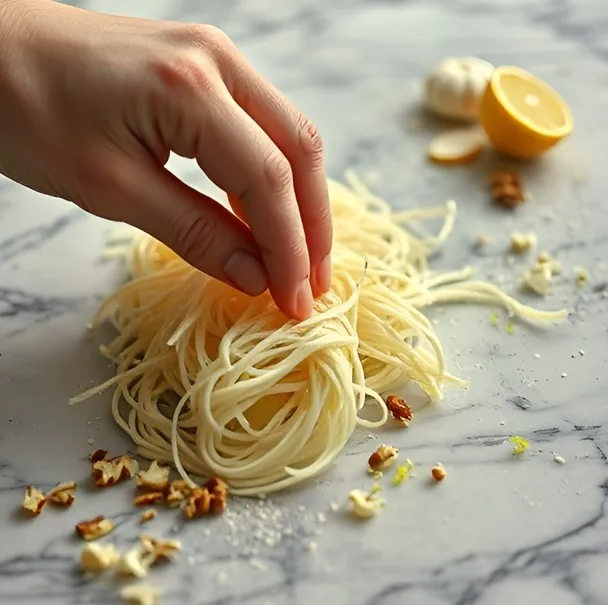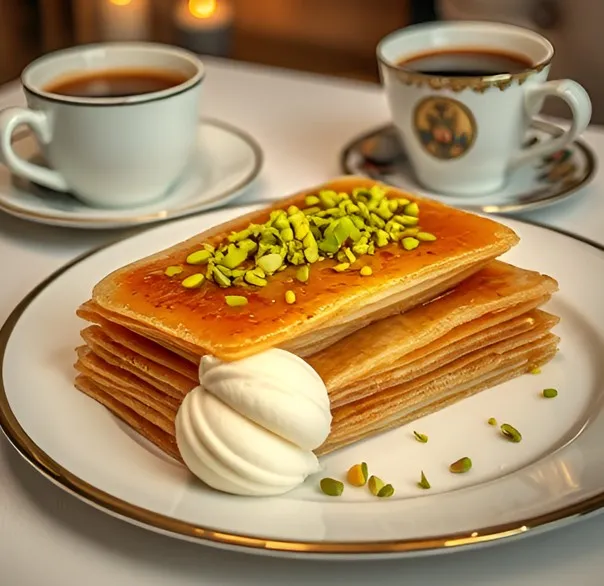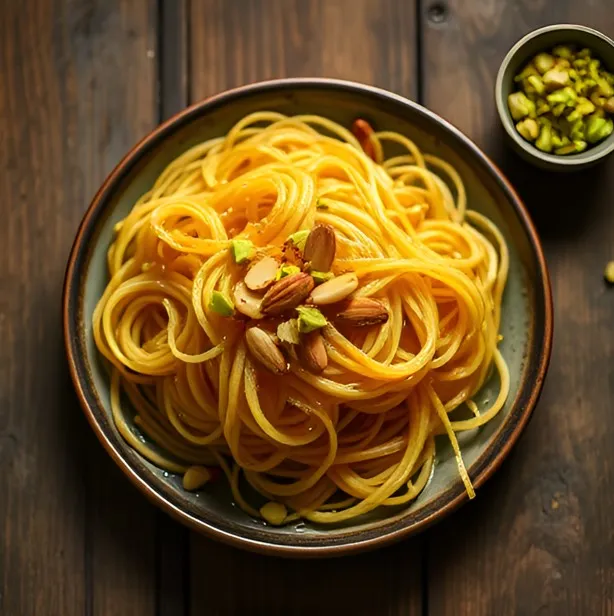Every dessert enthusiast dreams of mastering a treat that embodies both tradition and innovation. This guide will help you explore and master the art of Kataifi Pastry. Crafted with a reverence for culinary heritage, this creation is celebrated for its delicate texture, subtle sweetness, and intricate design. In this article, you will learn what makes Kataifi Pastry a unique and beloved dessert, while discovering techniques passed down through generations. Discover how Kataifi Pastry combines ancient techniques with modern flair to yield the perfect balance of crispness and moistness. Follow our step-by-step journey to create the ideal Kataifi Pastry that is sure to impress both family and friends with its sophisticated flavors and artisanal charm.
Table of Contents
A Brief History of Kataifi Pastry
Tracing its roots back to ancient times, the origins of Kataifi Pastry can be found in the rich culinary traditions of the Mediterranean and Middle Eastern regions. It is believed that the earliest versions of this dessert emerged when inventive bakers began experimenting with techniques to transform ordinary dough into something extraordinary. Many accounts suggest that what is now known as Kataifi Pastry started as a humble creation during celebrations and family gatherings, where shared meals played a vital role in community bonding.
Over the centuries, as cultures mingled and recipes were passed down and refined, this shredded treat became a symbol of festive indulgence and artistic cuisine. In ancient texts and culinary manuscripts, references to Kataifi Pastry can be found—highlighting its transformation from a simple dessert to a celebrated gourmet experience. Historians note that even in times of hardship, families managed to prepare a version of this treat, cherishing every opportunity to enjoy its delightful crunch. Many families proudly passed down the secret of making Kataifi Pastry from one generation to the next. Today, this beloved dessert stands as both a culinary masterpiece and a testament to centuries of innovation and artistry in pastry making. The enduring legacy of Kataifi Pastry highlights not only its historical significance but also its ability to bring people together through shared moments of indulgence.
Understanding the Essence
At the heart of this culinary marvel lies a delicate process that transforms a basic dough into an intricately woven dessert. Many believe that the secret behind Kataifi Pastry is its unique preparation, which elevates a simple recipe into an extraordinary culinary work. Each strand is carefully created, ensuring that the texture remains crispy on the outside while soft and syrupy within. The balance of these contrasting textures is what has made Kataifi Pastry a favorite among dessert lovers worldwide.
Artisans who have dedicated their lives to pastry making understand that achieving perfection requires meticulous attention to every step. The careful handling of the shredded dough not only preserves its structure but also ensures that each bite delivers a harmonious blend of crunch and sweetness. When the process is executed with precision, the result is a truly unforgettable Kataifi Pastry that delights both the eyes and the palate. In many kitchens, the term is spoken with a sense of reverence, as home cooks and professionals alike strive to recreate its legendary texture and flavor. A key factor in the success of Kataifi Pastry is the precise coordination between preparation and presentation. And ultimately, the essence of Kataifi Pastry is captured in the satisfaction derived from every carefully baked, syrup-soaked piece—a true labor of love.
Essential Ingredients
The foundation of this exquisite dessert lies in the careful selection of ingredients, as each plays a vital role in the creation of the final product. At its core, the dough for Kataifi Pastry is prepared by mixing high-quality flour, water, and a subtle addition of oil. The process of forming the dough and then delicately shredding it is crucial, ensuring that many thin strands come together to create a refined texture and structure.
Alongside the dough, a variety of finely chopped nuts such as walnuts, pistachios, or almonds are blended with select spices to form a rich filling. This mixture not only infuses the dessert with robust flavors but also adds a satisfying crunch that complements the sleek pastry. Experienced bakers know that the ratio of nuts to dough is essential in achieving the perfect balance. Every element contributes harmoniously toward the final presentation. Every artisan cherishes the moment when subtle hints of cinnamon or cardamom elevate the filled pastry, making it distinct from other desserts.
To complete the experience, a syrup is prepared by simmering sugar with water and a squeeze of citrus, sometimes accompanied by a dash of rosewater. This fragrant liquid is then drizzled over the baked dessert, allowing for a seamless blend of sweetness and texture. The infusion of the syrup binds the layers together and defines the lasting impression of Kataifi Pastry. Every step in creating Kataifi Pastry is infused with both care and precision, making each bite a testament to culinary art. Such dedication to detail makes the dessert not only a culinary achievement but also a cherished symbol of cultural heritage. The essential nature of Kataifi Pastry is celebrated in every well-prepared batch, uniting modern tastes with generational wisdom.
Step-by-Step Recipe
To embark on the journey of creating this delightful dessert, begin by preparing the dough with unwavering attention to detail. In a large bowl, combine the finest flour, water, and a modest amount of oil, stirring until the mixture forms a smooth, consistent dough. Allow it to rest for at least one hour, giving the gluten time to relax and the flour to fully hydrate. Once ready, gently pull and separate the dough into extremely fine, hair-like strands—a key step in obtaining the right texture for Kataifi Pastry.
While the dough rests, prepare your nut filling by finely chopping walnuts, pistachios, and almonds. Mix the chopped nuts with a hint of cinnamon and other spices as desired, keeping the flavors balanced. The nut mixture is integral to the authentic flavor of Kataifi Pastry. Next, carefully spread the shredded dough onto a greased surface, forming a thin layer that will serve as the canvas for the filling. Evenly distribute the nut filling over the dough, ensuring that every portion carries a blend of textures and tastes. Roll or fold the dough meticulously to encapsulate the filling, transforming it into a compact form ready for baking. This technique is essential for achieving the signature look of Kataifi Pastry.

Expert Tips and Tricks
Working with this intricate dessert demands both patience and precision. One valuable tip is to gently separate the dough strands by hand or with a fork, ensuring they do not clump together. This step preserves the airy, crunchy texture that is the hallmark of Kataifi Pastry. Maintaining a consistent oven temperature is essential; consider investing in an oven thermometer to monitor heat levels accurately for a uniform bake. Additionally, rotating your dish halfway through cooking can prevent uneven browning, which might compromise the dessert’s delicate structure.
It is also advisable to test the syrup’s sweetness before drizzling it over the baked dessert, making adjustments if necessary to balance the flavor perfectly. The art of preparing a robust syrup that complements rather than overwhelms the pastry is a skill honed with practice, much like crafting the perfect Kataifi Pastry. A final piece of advice is to allow the dessert to cool slightly after baking, as a warm pastry absorbs syrup more effectively, resulting in a harmonious blend of textures and flavors. Trust the process and experiment with small variations until you achieve a consistent result that meets your taste preferences. By following these expert tips, you can refine your technique and elevate your creation to a level that embodies all the qualities of a true Kataifi Pastry. Ultimately, the secret to expert success lies in understanding the nuances that differentiate a well-executed Kataifi Pastry from an ordinary dessert.
Serving Suggestions and Pairings
Presentation is as important as preparation when it comes to a dessert that is both visually appealing and richly flavorful. After the dish has set, plate your creation with a careful arrangement that highlights its golden, crisp layers. Serving it while still slightly warm can enhance the experience, as the interplay between temperature and texture elevates each bite.
Consider complementing your dessert with a scoop of velvety vanilla ice cream or a dollop of lightly sweetened whipped cream. The rich taste of Kataifi Pastry becomes even more pronounced when paired with contrasting temperatures. For a more refined presentation, garnish the plate with a sprinkle of finely chopped pistachios or a light dusting of powdered sugar. Such embellishments add a rustic charm while keeping the focus on the dessert’s signature texture and flavor. Enhancing the dining experience further, pair this delicacy with a cup of strong aromatic coffee or a spiced herbal tea. The bitterness of the beverage contrasts nicely with the sweet, indulgent layers, offering a multi-dimensional tasting experience. Ideologically, the artful display of Kataifi Pastry on your serving platter can transform an everyday meal into a celebration of culinary finesse. Every element, from the choice of plate to the final garnish, plays a role in accentuating the dessert’s beauty and flavor profile. A creative presentation can make your Kataifi Pastry the centerpiece of any festive occasion.

Creative Variations
While the traditional recipe remains a time-honored classic, modern chefs often explore creative twists to reimagine this delightful dessert. Experimentation can lead to innovative versions that maintain the essence of the original while introducing new flavors and textures. One popular variation involves incorporating layers of fruit preserves—such as apricot or raspberry—to create a subtle contrast with the nutty filling, redefining Kataifi Pastry for a contemporary palate. Others may opt to infuse the dough with a hint of coconut or add a dash of chocolate to the nut mixture, resulting in a fusion of flavors that pays homage to the dessert’s rich heritage. A creative approach preserves the essence of Kataifi Pastry while allowing for personal expression in the kitchen. Chefs who experiment with substitutions for traditional ingredients can open new avenues for flavor exploration, ensuring that every variation remains both innovative and respectful of the dessert’s origins. Such inventive adaptations reaffirm the versatility and enduring appeal of Kataifi Pastry.
Frequently Asked Questions
Q: What is Kataifi Pastry made of?
A: The dessert is created using a delicate blend of flour, water, and oil that forms a dough, which is then skillfully shredded to create a unique texture.
Q: Is Kataifi Pastry similar to filo pastry?
A: Although both involve thin layers, Kataifi Pastry is distinguished by its finely torn, fibrous structure and is typically assembled with a generous nut filling, setting it apart from the layered, flat sheets of traditional filo pastry.
Q: Can I experiment with different fillings or syrups?
A: Absolutely. Many cooks enjoy personalizing their recipe by varying the nut mixtures, spices, or even incorporating fruit preserves. The flexibility of Kataifi Pastry allows for both classic preparations and innovative recreations, making it a versatile dessert that caters to a wide range of tastes.
Final Thoughts
In conclusion, this guide has provided a comprehensive look at every facet of creating a dessert that truly embodies culinary artistry and cultural heritage. Mastering the techniques and traditions behind Kataifi Pastry not only allows you to produce a visually stunning treat but also connects you to a long lineage of gastronomic excellence. May your endeavors in crafting this intricate dessert bring you both joy and a sense of accomplishment, and may your journey inspire you to explore the further depths of culinary creativity.

